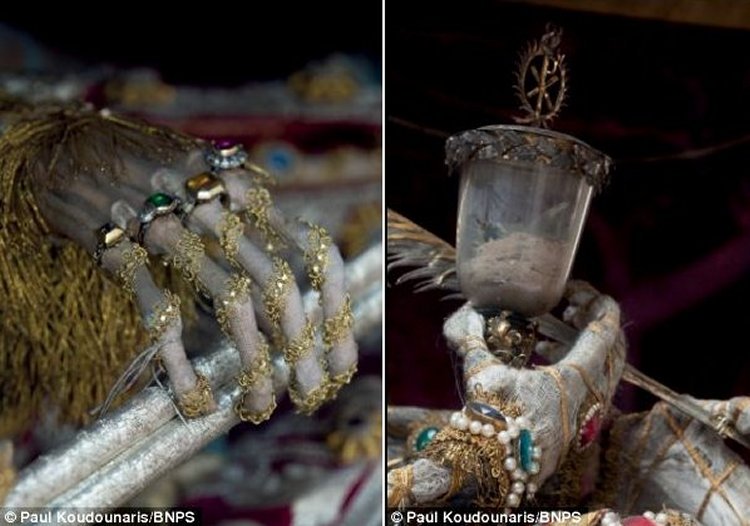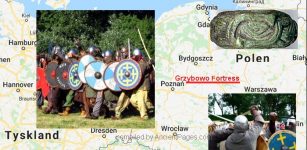Secret Catacombs With Incredible Ancient Skeletons Covered In Priceless Jewelry
A. Sutherland - AncientPages.com - These ancient skeletons are said to be remains of Catholic martyrs dug up from Roman catacombs.
The bodies are covered in priceless ancient treasure and they are a truly gruesome sight.
The bodies were discovered by art historian Paul Koudounaris who hunted them down in secret Catholic vaults in Rome and churches across Europe.

The bodies were discovered by art historian Paul Koudounaris who hunted them down in secret Catholic vaults in Rome and churches across Europe. Image: Paul Koudounaris
Incredibly, some of the skeletons, said to be the remains of early Christian martyrs, were even found hidden away in lock-ups and containers.
In his book, Heavenly Bodies: Cult Treasures and Spectacular Saints from the Catacombs, Paul Koudounaris offers an intriguing visual history of the veneration in European churches and monasteries of bejeweled and decorated skeletons.
"Death has never looked so beautiful. The fully articulated skeleton of a female saint, dressed in an intricate costume of silk brocade and gold lace, withered fingers glittering with colorful rubies, emeralds, and pearls-this is only one of the specially photographed relics featured in 'Heavenly Bodies'.

St Benedictus: Thousands of skeletons were dug up from Roman catacombs in the 16th century and installed in towns around Germany, Austria and Switzerland on the orders of the Vatican
In 1578 news came of the discovery in Rome of a labyrinth of underground tombs, which were thought to hold the remains of thousands of early Christian martyrs.
Skeletons of these supposed saints were subsequently sent to Catholic churches and religious houses in German-speaking Europe to replace holy relics that had been destroyed in the wake of the Protestant Reformation.
The skeletons, known as "the catacomb saints," were carefully reassembled, richly dressed in beautiful and fantastic costumes, wigs, crowns, jewels, and armor, and posed in elaborate displays inside churches and shrines as reminders to the faithful of the heavenly treasures that awaited them after death. Read more.

Long dead: The hand of St Valentin in Bad Schussenreid, Germany (left) and St Munditia, in the church of St Peter in Munich (right).
Paul Koudounaris gained unprecedented access to religious institutions to reveal these fascinating historical artifacts. He believes that it's impossible to put a modern-day value on the skeletons.
Hidden for over a century as Western attitudes toward both the worship of holy relics and death itself changed, some of these ornamented skeletons appear in publication here for the first time."
"After they were found in the Roman catacombs the Vatican authorities would sign certificates identifying them as martyrs then they put the bones in boxes and sent them northwards.
The skeletons would then be dressed and decorated in jewels, gold and silver, mostly by nuns.

St Benedictus: Thousands of skeletons were dug up from Roman catacombs in the 16th century and installed in towns around Germany, Austria and Switzerland on the orders of the Vatican
They had to be handled by those who had taken a sacred vow to the church - these were believed to be martyrs and they couldn't have just anyone handling them. They were symbols of the faith triamphant and were made saints in the municipalities.
One of the reasons they were so important was not for their spiritual merit, which was pretty dubious, but for their social importance.
They were thought to be miraculous and really solidified people's bond with a town. This reaffirmed the prestige of the town itself.
Written by – A. Sutherland - AncientPages.com Senior Staff Writer
Copyright © AncientPages.com All rights reserved. This material may not be published, broadcast, rewritten or redistributed in whole or part without the express written permission of AncientPages.com
Expand for referencesReferences:
P. Koudounaris, Heavenly Bodies: Cult Treasures and Spectacular Saints from the Catacombs
More From Ancient Pages
-
 500-Hundred-Year-Old Mystery Of Aztecs’ Death May Have Been Solved – New Study
Archaeology | Jan 17, 2018
500-Hundred-Year-Old Mystery Of Aztecs’ Death May Have Been Solved – New Study
Archaeology | Jan 17, 2018 -
 Christian Church And Large House Unearthed In Ancient Laodicea, A Major Hub Of Christianity
Archaeology | Oct 31, 2020
Christian Church And Large House Unearthed In Ancient Laodicea, A Major Hub Of Christianity
Archaeology | Oct 31, 2020 -
 Unexpected Discovery Of Huge Iron Age Roundhouse At Dinas Dinlle, Wales
Archaeology | Sep 9, 2019
Unexpected Discovery Of Huge Iron Age Roundhouse At Dinas Dinlle, Wales
Archaeology | Sep 9, 2019 -
 Five Rare Bronze Age Axe Heads Found In Polish Forest
Archaeology | Dec 8, 2023
Five Rare Bronze Age Axe Heads Found In Polish Forest
Archaeology | Dec 8, 2023 -
 Rene Descartes – Independent French Thinker And His Main Ideas
Featured Stories | Apr 27, 2021
Rene Descartes – Independent French Thinker And His Main Ideas
Featured Stories | Apr 27, 2021 -
 Ancient Depictions Of Eyes Reveal The Untold Story Of The Human Race – Professor Discovered
Ancient Mysteries | Apr 19, 2019
Ancient Depictions Of Eyes Reveal The Untold Story Of The Human Race – Professor Discovered
Ancient Mysteries | Apr 19, 2019 -
 Remarkable Ancient High-Tech Genetic Disc Could Re-Write Ancient History
Artifacts | Sep 15, 2014
Remarkable Ancient High-Tech Genetic Disc Could Re-Write Ancient History
Artifacts | Sep 15, 2014 -
 Magnificent Solar Alignment Phenomenon In Abu Simbel – The Sun Illuminates The Face Of Pharaoh Ramses II
Featured Stories | Nov 11, 2020
Magnificent Solar Alignment Phenomenon In Abu Simbel – The Sun Illuminates The Face Of Pharaoh Ramses II
Featured Stories | Nov 11, 2020 -
 Medieval Ring Found In Piast Stronghold Near Gniezno, Poland – Is A Unique Christian Artifact
Archaeology | Nov 28, 2019
Medieval Ring Found In Piast Stronghold Near Gniezno, Poland – Is A Unique Christian Artifact
Archaeology | Nov 28, 2019 -
 Floors In Ancient Greek Luxury Villa Were Laid With Recycled Glass
Archaeology | Jul 25, 2022
Floors In Ancient Greek Luxury Villa Were Laid With Recycled Glass
Archaeology | Jul 25, 2022 -
 Vijayanagara – ‘City Of Devas – Shining Ones’ – Place Where Mythology And History Coexist
Civilizations | Jun 21, 2015
Vijayanagara – ‘City Of Devas – Shining Ones’ – Place Where Mythology And History Coexist
Civilizations | Jun 21, 2015 -
 First Bronze Age Settlement Predating The Phoenicians Discovered In Maghreb
Archaeology | Mar 5, 2025
First Bronze Age Settlement Predating The Phoenicians Discovered In Maghreb
Archaeology | Mar 5, 2025 -
 Underground Bronze Treasures Unearthed In 2,300-Year-Old Chengdu, China’s Sichuan Province
Archaeology | Mar 7, 2017
Underground Bronze Treasures Unearthed In 2,300-Year-Old Chengdu, China’s Sichuan Province
Archaeology | Mar 7, 2017 -
 Shining Ones, Archimedes Death Ray And Mystery Of Vitrified Forts In Scotland
Ancient Technology | May 13, 2015
Shining Ones, Archimedes Death Ray And Mystery Of Vitrified Forts In Scotland
Ancient Technology | May 13, 2015 -
 Ancestral Home Of All Humans Revealed Through World’s Largest Genome Reconstruction Of Our Ancestors
Archaeology | Jan 3, 2023
Ancestral Home Of All Humans Revealed Through World’s Largest Genome Reconstruction Of Our Ancestors
Archaeology | Jan 3, 2023 -
 Archaeologists Discover A Secret Escape Tunnel In Copenhagen, Denmark
Archaeology | May 5, 2020
Archaeologists Discover A Secret Escape Tunnel In Copenhagen, Denmark
Archaeology | May 5, 2020 -
 Countless Artifacts, Structures And Roads Discovered In Ancient City Of Aigai, Turkey
Archaeology | May 16, 2022
Countless Artifacts, Structures And Roads Discovered In Ancient City Of Aigai, Turkey
Archaeology | May 16, 2022 -
 Fabel: World’s First Archaeology Dog Helps To Unravel The Mystery Of Sandby Borg
Archaeology | May 10, 2016
Fabel: World’s First Archaeology Dog Helps To Unravel The Mystery Of Sandby Borg
Archaeology | May 10, 2016 -
 Unknown Prehistoric Henge Site Detected Near Famous Newgrange In Ireland’s East Coast
Archaeology | Jul 13, 2018
Unknown Prehistoric Henge Site Detected Near Famous Newgrange In Ireland’s East Coast
Archaeology | Jul 13, 2018 -
 Treasure Hoard Of Rare Gold Coins From The Crusader Conquest Discovered In Caesarea, Israel
Archaeology | Dec 8, 2020
Treasure Hoard Of Rare Gold Coins From The Crusader Conquest Discovered In Caesarea, Israel
Archaeology | Dec 8, 2020
